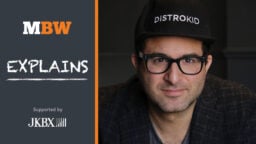The direct-to-fan model is arguably one of the music industry’s key democratizers of the digital age.
This was evidenced by independent artists’ ability to sell merch and music directly to their fanbases becoming a financial lifeline during the pandemic when concert revenues all but disappeared.
Monetizable online fan communities have also proved to be lucrative additions to the balance sheets of entertainment giants, like HYBE for example, whose own direct-to-fan platform Weverse was cited as a key revenue driver for the K-Pop firm in 2020.
A prominent company offering e-commerce tools allowing musicians to market and sell products directly to their fanbases is music website hosting company Bandzoogle.
Currently powering over 60,000 sites, Bandzoogle’s suite of direct-to-fan tools for artists includes web stores for selling music, merch and tickets, plus crowdfunding, fan subscriptions and mailing lists.
Launched in Canada in 2003, Bandzoogle just reached a key milestone, surpassing $100 million in sales generated by artists via websites powered by the company. Over half ($52.7m) of that sales figure, according to Bandzoogle, was generated in the last five years alone.
Bandzoogle claims that it has never taken a cut of those sales since launching direct-to-fan eCommerce tools in 2010, with members paying a fixed monthly fee, starting at $8.29 per month for the ‘Lite’ tier, to $16.63 per month for the “Pro” tier.
“The biggest difference between Bandzoogle and other direct-to-fan offerings is that we are 100% commission-free,” CEO Stacey Bedford tells MBW.
“We’re also fully bootstrapped, so we’re not beholden to a board of directors. Our team is made up of mostly musicians, and we’re basically building out the tools we need as artists to be successful online.”
Bedford suggests that Bandzoogle’s longevity in the direct-to-fan space is owed to making the right bets, “on which emerging technologies to focus our (small but mighty) resources on”. She adds: “We’re like the roadie you can trust to give you the best, most relevant tools and advice.”
Some of those bets were placed in 2019 when Bandzoogle launched both commission-free crowdfunding, and built-in commission-free fan subscriptions. And also in 2020, when the platform launched a tip jar feature.
Bedford tells MBW that Bandzoogle’s tip jar and fan subscriptions represent around 5% – or $5 million – of the company’s total musician sales combined. She adds that the platform has even seen some of its members earning “well over 6-figures” from fan subscriptions.
Breaking down the source of Bandzoogle’s $100 million artist sales tally further offers a fascinating insight into what music fans are spending money on today. According to Bandzoogle, merchandise represents 75% (or $75 million), of that total $100 million sales figure.
Merch was also the top income generator for over 70% of the top 50 sellers across Bandzoogle’s 60,000 hosted websites last year.
“It’s important for musicians to offer merch and to have a merch strategy,” notes Bedford.
Looking to the future, Bedford argues, that, “with artists having the ability to market and sell their own music and having access to more and more tools to do so, we’re going to continue to see the rise of the independent artist in the coming years”.
Adds Bedford: “The pandemic really forced artists to think outside of traditional income streams. Some of these tools were available to artists before the pandemic, but when the world shut down they were really forced to try out different revenue models.
“And although artists are returning to record, release, tour – they now also have those virtual merch stores open, and they’re engaging fans in new and interesting ways behind gated content.”
Here, Bedford tells us about the company’s $100 million artist sales milestone, the firm’s positioning in the music industry, and why it’s so important for artists to have a clear merch strategy…
Musicians have now sold over $100 million in music & merch through their websites powered by Bandzoogle. Tell us about the significance for the platform of reaching this milestone?
As a business leader, especially when faced with a looming economic downturn, it’s easy to focus on your own metrics. But if you put energy into your customers’ objectives, it will have a direct correlation to your own success.
It’s all about bringing value, and during a time when artists had to move their operations online, and eventually move back to live entertainment at lower capacities, Bandzoogle managed to help members earn even more money.
This milestone has been like getting to throw a parade to celebrate everyone instead of just yourself. Relative to the size of our customer base, this happened really quickly. This has really told me that in the last 5 years especially, we’re making the right decisions when it comes to product development and forecasting.
How does Bandzoogle want to be positioned in the wider music industry?
We’re a company that is solely focused on putting more money in the pocket of creators. Whether that’s direct-to-fan sales tools, better fan engagement options like mailing list, and social media integrations; or even streamlined collaborations with like-minded artist services, we strive to be the best, easiest all-in-one platform for artists online today.
If we can create the tools that artists need to accomplish their goals, whether that’s a full-time career in music, creating a hub that is professional and engaging for their fans and collaborators, then we are properly positioned.
What trends are you seeing across Bandzoogle in terms of the use of the different eCommerce tools available on the platform?
In the last five years, we’ve seen that merch has become the most important source of revenue for our members. Merch was also the top income generator for over 70% of our top 50 sellers in 2022.
But we’re also seeing more diversification in the types of revenues artists generate through their websites.
This means that musicians are offering their fans more ways to support them through offering merch, digital music, fan subscriptions, donations, and tickets to shows.
What trends are you seeing in terms of the number of artists signing up to your different pricing plans?
Our Pro plan has been the most popular in recent years. Although we haven’t increased pricing in over 17 years, we do tend to add new features to our higher tier plans. This option has a really vast eCommerce offering, including selling merch, print-on-demand merch, ticket sales, fan subscriptions, bundling and upselling options, inventory tracking, and more.
But we make it easy to change between plans, so oftentimes users will start with the Lite or Standard plans and upgrade once they get more content together and the need arises to add Pro level features.
Lastly, we notice that pro level members tend to stick around for longer; artists who are leveraging the full suite of tools available to them tend to do better than if they just focus on one or two music marketing or sales options.
Over half of the $100m in sales by Bandzoogle members has been generated in the last 5 years alone – What does this stat tell us about the rising value of the independent artist space in recent years?
It tells us a few things, and in my opinion the most important one is that more than ever, fans understand the importance of supporting artists directly. It also tells us that musicians are becoming more attuned to direct-to-fan marketing and sales, so they’re taking advantage of our built-in eCommerce tools to further monetize their music careers.
Merch played a big role in that $100m milestone, representing 75% of total revenue. What can artists and their teams learn from that stat and what trends are you seeing in the merch space?
That it’s important for musicians to offer merch and to have a merch strategy. It’s easy to get started with print-on-demand, like our integration with Printful. That way you don’t have to store inventory, and you only pay the cost on items when they sell.
It’s also important to offer items at different price points, as all fans are different. Basically, you want to garner an understanding of your audience, and provide an offering that you think would be well received. How do your fans want to support you? Is it as a walking billboard, sporting a band T-shirt, or is it by gifting a limited edition vinyl? Artists who are doing well on our platform are having fun with this and really thinking outside the box.
One band released a custom tea blend to drink during a listening party; another artist put on a terrible cooking show via live stream and sold tickets while his fans listened to his songs and shared stories. The important lesson here is that they’re having fun with the options available, and it’s clearly well-received by their fans.
How big is digital/virtual merchandise getting?
While still relatively small compared to physical merch, digital merch is easily scalable. So we’re seeing more and more artists offering things like sheet music, digital lyric books, sample packs, video content and more for their fans to buy.
We believe this will only continue to increase and become an even more important source of revenue for artists. Most things can be digitized, whether it’s services, experiences, or goods, and that trend will continue in the years to come.
Bandzoogle also offers a tip jar tool and fan subscription feature for artists’ websites. How much of the overall sales mix do they account for?
Our tip jar and fan subscriptions represent about 5% of our total sales combined, but I don’t think they should be overlooked as part of an artist’s overall revenue strategy for a couple of reasons.
Firstly, they’re relatively new features for Bandzoogle. So compared to music and merch sales, they’ve only been offered for a short time. And with fan subscriptions, it’s still quite niche, but represents recurring revenue for artists that you can build on over time.
We’ve seen some of our members earning well over 6-figures using our fan subscriptions feature. But even if you’re earning $100 a month, that’s recurring income that adds up over time.
What are your predictions for the direct-to-fan sales and marketing space over the next few years?
With artists having the ability to market and sell their own music and having access to more and more tools to do so, we’re going to continue to see the rise of the independent artist in the coming years.
The pandemic really forced artists to think outside of traditional income streams. Some of these tools were available to artists before the pandemic, but when the world shut down they were really forced to try out different revenue models.
And although artists are returning to record, release, tour – they now also have those virtual merch stores open, and they’re engaging fans in new and interesting ways behind gated content.
What are Bandzoogle’s goals/ ambitions and plans for the company over the next 12 months?
Although I can’t reveal our secrets, you will see Bandzoogle adapting our plans and offerings to represent what artists need today. We play well with others, and love to create integrations with ethical, like-minded music partners so that bands can access everything they need to succeed online, in one place.
As always, we strive to remain ahead of the curve when it comes to building relevant tools for musicians. We aim to create a place for artists that is so easy to use, from anywhere. Whether they’re on tour or at the recording studio, our all-in-one full suite of tools is at your fingertips. Best of all, we’re having a great time together doing it.
Music Business Worldwide




